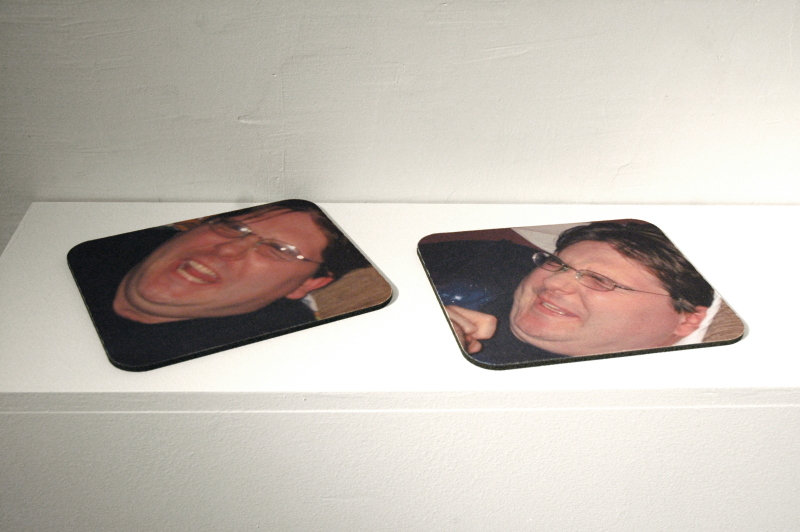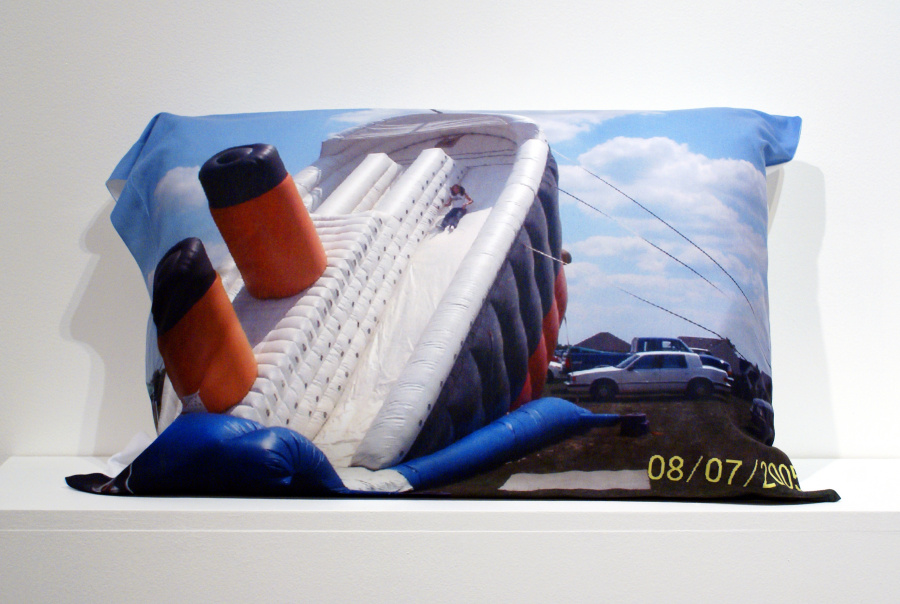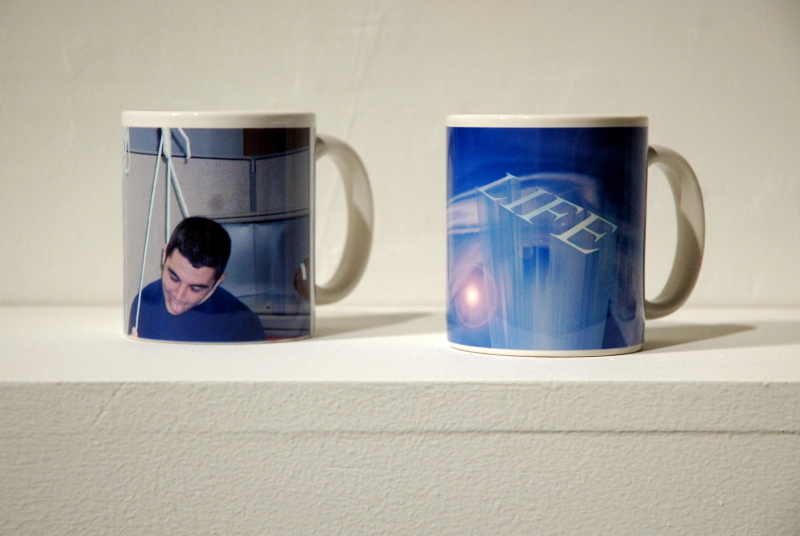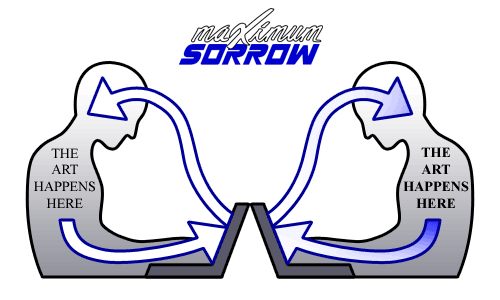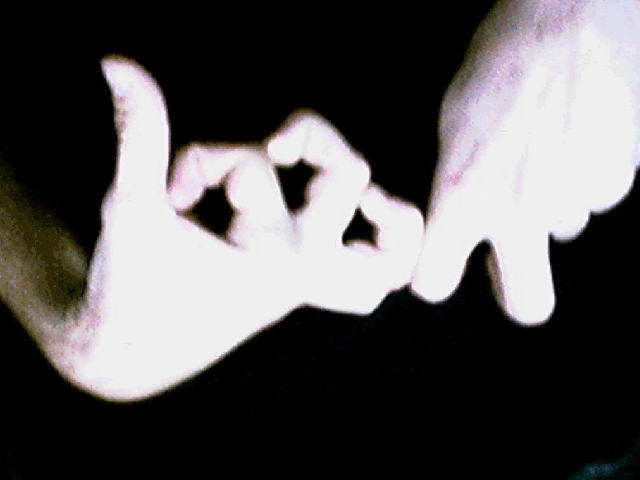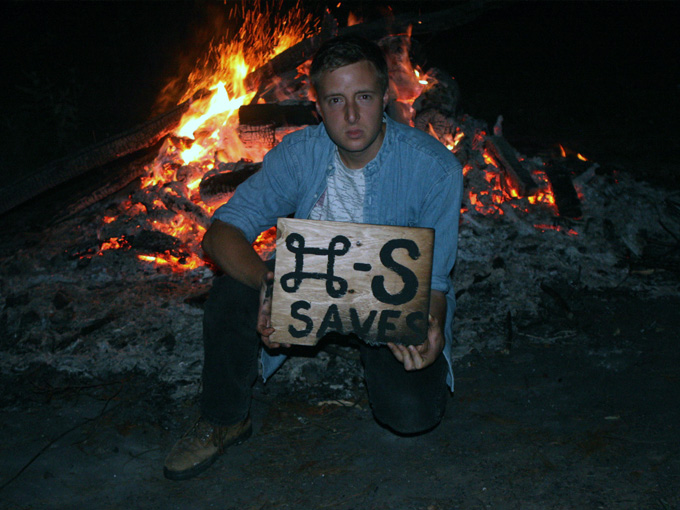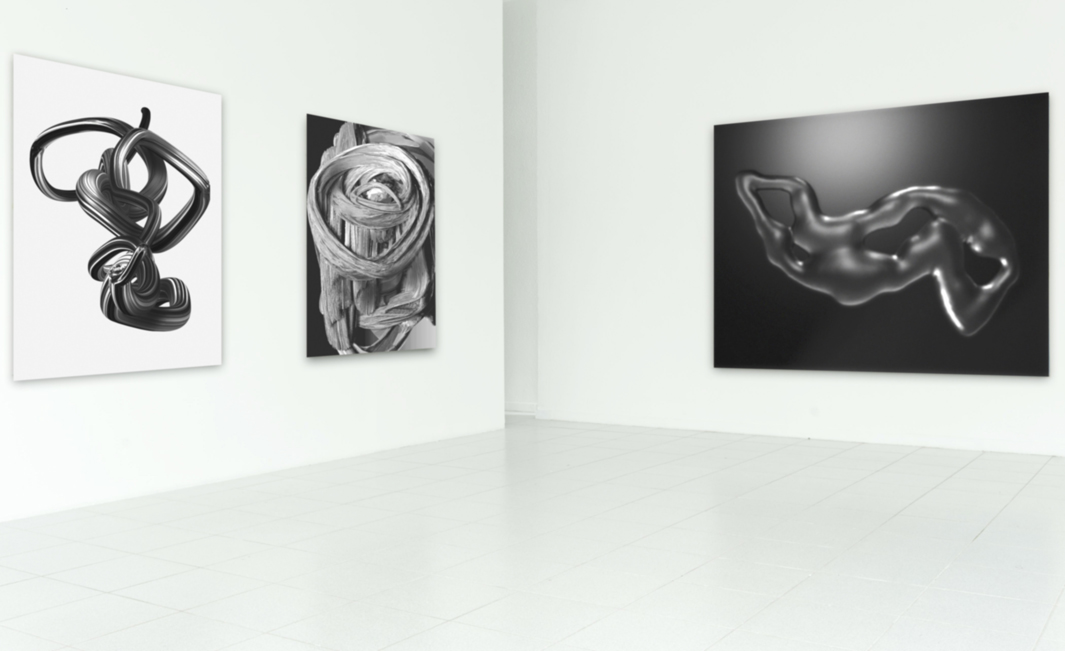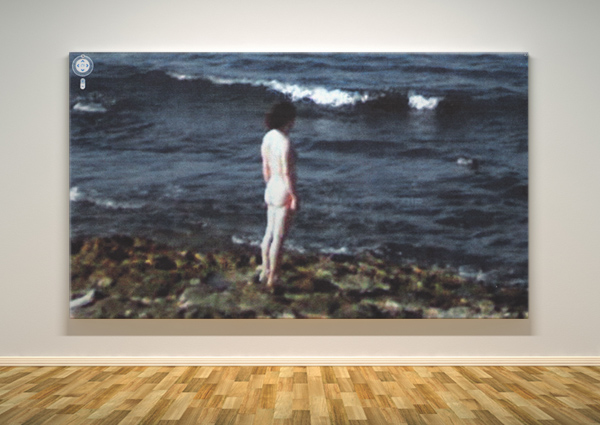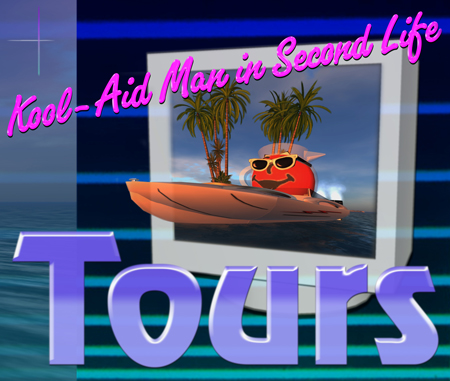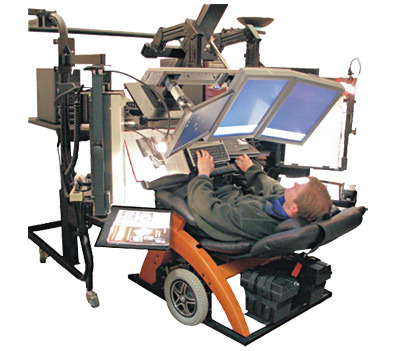INTRODUCTION |
 |
 |
|
 |
As you are reading this, the index of the internet is expanding, comprised of data that contains, in the end, diverse meaning, but which is fundamentally reduceable to bits of binary code, just two digital digits. The database nature of this useful tool is continually updated, the threads of the web always connecting to new corners of our virtual environment, thus we can never quite sure of where we are within this digital space. Within our everyday lives, we use the internet as a tool for communication and access to information; to our bank accounts and our Facebook, movie listings and scholarly papers. We have an understanding of a menu within a computer, where we can access the tools we require: copy, paste. We use keyboard shortcuts to get there faster. It should be understood that this is changing our minds. That this structure of information access is not our natural way, but the ontology of the machines. Man made machines affecting the nature of man. This is something that we talk to our therapists about, that frames the way we interact with each other and most importantly in this instance, continues to evolve our understanding of art.
 New internet art works are made every day. They have been, intentionally or unintentionally, since the dawn of our networked era. (1990! That is 20 years!) The artists and art work which I discuss in this paper are from the last four years, contemporary even in internet time. In my rising interest in these kinds of art works in the past few years, I have found it continually difficult to keep up: the pace of the internet is fast, often instantaneous, and while this makes distribution of works and dispersion of ideas rapid, there is a continual feeling of only seeing part of the picture. And this is just that, a look at three artists and two artists groups amongst thousands of people who make work of this kind. You will find a list in my bibliography of all of the people I planned to write about for this paper, which I quickly realized was impossible with my time-frame for this paper and which I will begin addressing next quarter. This is my life, my future, and I hope to someday write about all of this amazing artwork that continually confronts me with new visions of what art can be. At the very least let these essays serve as a written document of some work that is housed, for now, within the glorious web I consider my home away from home.
New internet art works are made every day. They have been, intentionally or unintentionally, since the dawn of our networked era. (1990! That is 20 years!) The artists and art work which I discuss in this paper are from the last four years, contemporary even in internet time. In my rising interest in these kinds of art works in the past few years, I have found it continually difficult to keep up: the pace of the internet is fast, often instantaneous, and while this makes distribution of works and dispersion of ideas rapid, there is a continual feeling of only seeing part of the picture. And this is just that, a look at three artists and two artists groups amongst thousands of people who make work of this kind. You will find a list in my bibliography of all of the people I planned to write about for this paper, which I quickly realized was impossible with my time-frame for this paper and which I will begin addressing next quarter. This is my life, my future, and I hope to someday write about all of this amazing artwork that continually confronts me with new visions of what art can be. At the very least let these essays serve as a written document of some work that is housed, for now, within the glorious web I consider my home away from home.
This document contains numerous links to works which exist outside of this page. Please be sure to explore the resources provided.
Please also take this statement into consideration:
"Everything said is said to an observer; knowledge of reality is dependent upon the perceptions of the observer. Observation or measurement affects the state of the object being observed–that is, objective measurement or observation from outside a system is not possible, and the act of observing makes the observer part of the system under study." [p. 146]
-Lev Manovich, Database As Symbolic Form [full text online] See also: The Uncertainty Principle
KEVIN BEWERSDORF

"The Marketplace is empty of everything but products; you are the Product, and therefore contribute to the market; Info is the free-flowing energy generated by your production and consumption. The INFOspirit, which encompasses all of these concepts, is both the state between the knowable and unknown, and mediocrity in its purist form." –Kevin Bewersdorf
[source]
Kevin Bewersdorf believes in the INFOspirit. A devout INFOmonk and one of the founders of an internet surfing club called Spirit Surfers, which uses the framework of a dual-part blog post, the 'BOON' and 'WAKE' of an internet quest, to express the transcendent and enlightening nature of the surf search. The Boon, Bewersdorf states, "is revealed at the eureka moment of a surf when the surfer becomes enlightened by the INFOspirit." Removed from their original context, these "jewels" are placed within the frame of Spirit Surfers, and paired with ephemera from the surf, the Wake of the jewel itself. The INFOspirit is Bewersdorf's name for the internet, but less so the physical framework of the network itself than the contents that it contains and through them, the creators behind the content. The enlightened surfer, conscious of the possibility in this quest, is an INFOmonk in search of affirmation that their information prayers have been digitally answered. The members of Spirit Surfers function under varying degrees of anonymity, offering up their jewels in worship the internet itself.
Outside of Spirit Surfers, Bewersdorf began functioning under the corporate moniker of Maximum Sorrow in 2007 in response, it seems, to the life of a contemporary artist in the digital age. In an online biographical statement, he identifies these activities as;
|
|
|
|
|
|
|
[source] |
|
This seems just as pertinent in 2010 if not moreso; now Facebook and Twitter are important social media sites to which many contemporary artists make a daily pilgrimage, and those are but two of the larger sites available to propagate the cult of the artist online. This understanding of the role of the artist spurred Bewersdorf to function under the guise of the corporate systems that the art world has begun to freely and unashamedly emulate. Adopting a logo and using the same methods as big business, Bewersdorf employed "marketing techniques that construct my presence in the spirit world of the web."
| Kevin Bewersdorf Google image search results for “pain” printed onto mouse pads by Walgreens.com, 2007 9.25 x 7.75 inches each |
|
| Kevin Bewersdorf Google image search results for "Titanic" printed on pillowcase by Walgreens.com, 2007 17 x 25 x 7 inches |
|
| Kevin Bewersdorf Life Mug 1, 2007 Life Mug 2, 2007 4 x 3.5 x 4.5 inches each |
|
|
Bewersdorf extended his online presence into the physical realm in a 2007 exhibition at And/Or Gallery in Dallas, Texas. Using the internet as both a source of content and a means of production, Bewersdorf used image search results for terms such as 'Woodstock', 'Pain' and 'Life' and had them printed onto pillowcases, mugs, coasters and mousepads using sites such as Walgreens.com which began offering these production services online. By removing the hand slightly further than Duchamp could during his time, Bewersdorf brings the readymade, as well as the role of artistic choice, into the internet age. These objects represent an implausable aesthetic combination mediated by Bewersdorf; of the millions of image results available at the query of such common terms, the choices that determine the final result are distinctly his and despite the endless possibilities, a disparate aesthetic emerges through the body of work.
Bewersdorf constructed an animated gif which perfectly expresses the nature of much of the work which we will be looking at in this cross-section of internet artists and artworks. This shows two users seated at their individual computers, both consuming and contributing information to the INFOspirit. What is interesting is that Bewersdorf places the location of "the art" inside of the user and not within the computer and internet infrastructure which physically contains it. This diagram expresses also the circular flow of connection between users of these modern machines. The flow of art and/or information from one user to another, and their reciprocal flow of information back into the internet realm, is the foundation of internet exchange, each user taking from and adding to the database of the web.
This seems important because many internet based artworks meanings are lost to their audience who become transfixed on the method of production and delivery rather than the message behind them. The relates of course to the work of the scholar Marshall McLuhan in his book "Understanding Media: The Extensions of Man" of 1964, wherein he asserts that the message of an artwork is lost to the media which illustrates it. Early internet artworks focused extensively on the new technologies that were used to create the work, and the role of the human body and spirit when interacting with these methods. What has begun to arise and what I will discuss with more recent internet artists is that the medium itself has become less of a focus as the source of content for the work; as these technologies have become thoroughly ingrained in our daily understanding of the world, and has begun to address culture at large.
In a blog project by fellow net artist Rafael Rosendaal called 'One Question Interview', Bewersdorf was asked, "What does the Internet lack?". His answer, in poetic form, contains one of my favorite statements about the internet:
|
|
|
|
|
|
|
|
What Bewersdorf expresses is the bounty of the internet content generated by users far overshadowing the physical and technological framework that supports these exchanges. What this means for the user is a constantly changing environment which is beyond the control of a single entity, one in which the information is diffuse and varied and often of questionable provenance. What and where we arrive within this web is determined by what and how we seek, our spiritual surfs are a process of finding ourselves in digital ephemera created by countless, often nameless others. This mimics more poetically Lev Manovich's ideas about the database nature of the web and the aesthetics it implies. In his essay 'Database as Symbolic Form' Manovich says of the hyperlinked structure of the internet, "Thus the same data would give rise to more indexes than the number of data elements themselves." [p. 44]
The true sorrow of the work of Kevin Bewersdorf is that beginning in 2009, he took down every single one of his websites of his artwork, redirecting all of them to PureKev.com, which over the course of the three years allotted for the performance piece grows line by line, <br> by <br>, in a screen of blue (#0000FF, to be exact), with a tiny gif of light at the bottom which shrinks as time passes. Bewersdorf's light on the web is dwindling, and the methodical removal of his web presence being replaced by this online representation of time, in an environment where time is rarely delineated or recognized, unannounced change is expected, and instantaneity is the most common result.
SPIRIT SURFERS 

Blogs have now become ubiquitous soundboards for anyone to establish an online archive of their thoughts, photographs or collected media ephemera, available to the public and part of a network often affiliated with the blogging platform in which it exists. What began as personal journals on sites such as LiveJournal and Diaryland has become something that is at once indefinable and yet seems to contain everything within it. Much like a book or film can contain any and all subjects, likewise blogs are a structural vessel which are filled by the author or artist.
| Boon post from Spirit Surfers |
This open system allows for as much or as little focus as one can imagine. What artists Kevin Bewersdorf and Paul Slocum did in 2008 was invite other internetters to participate in a group blog which used a size constraint to somewhat limit the content that could be posted. The second constraint was that of the Boon/Wake, which is the only available information of their site, stating, "let the boon be the made/for the wake to unmake" [source]. Bewersdorf discusses this in an essay about Spirit Surfers from the year of its foundation, elaborating on the concept of Boon and Wake and the difference between INFOmonks and INFObrats. As this text is an endangered document removed by Bewersdorf in his PUREkev performance piece, I reproduce it here in full for posterity. Or, skip this.
|
|
|
|
|
|
|
|
|
An image from Kevin Bewersdorf's last post on Spirit Surfers.
The first curatorial step was choosing the participants, the INFOmonks that would contribute content to the Spirit Surfers site. From there, the curatorial action was in their hands. Users post their boons and wakes as individual posts, which are then thrust into the conversation of the other posts by other users. This is where the internet surf club conversation happens. In a "stack" of posts, the media which is visible on t he front page of the blog (until recently limited to 5 posts at a time, recently expanded to 6), a dialogue develops between the images posted by various users. A new post must be made with a mindfulness to the posts that have come before. This sounds poetic in theory, and recalls my own personal feelings about contemporary art practive, but in effect it is a visual dissonance or harmony which begins to form among disparate elements. The viewers and followers of this blog interact via comments to the posts which solidify these visual and conceptual cues present in the Spirit Surfers stack.
PAINT FX
Paint FX is an internet-based art collective involving John Transue, Tabor Robak, Parker Ito, Micah Schippa and Jon Rafman, who are spread across the US and Canada. At their website paintfx.biz, they post without title or context digital abstract paintings which reference heavily the style of Abstract Expressionism. These works are made using computer applications which are comprised of various 'paint brushes' that mimic digitally the unique strokes of painterly tools. These brushes and other effects contained within the software are openly available for public use, and are commonly used to correct photographs or create images used in 2D animations, yet in the hands of this group of contemporary artists they are used to hearken back to postwar painting of America and Europe from 1945 onward.
 What is interesting is what happens to the idea of Abstract Expressionism when looking at these modern counterparts; what those painters found in affect, passionate material gestures of wild painterly abandon, Paint FX find in effect, mastering control over digital medias and finding a way to navigate aesthetic space. They adopt the painterly affect, the strong hand of the artist, and pair that bravado with Photoshop (Maya, Artrage, etc.) effects to produce a painting of artistic consideration with a meaning which holds a mirror to the paintings which hang and gather dust in museums around the world. With multiple layers of workspace and three dimensional modeling tools available within these programs, the artists are producing work with depth and substance that have a digital viscerality not often found in 72 dpi .jpgs.
What is interesting is what happens to the idea of Abstract Expressionism when looking at these modern counterparts; what those painters found in affect, passionate material gestures of wild painterly abandon, Paint FX find in effect, mastering control over digital medias and finding a way to navigate aesthetic space. They adopt the painterly affect, the strong hand of the artist, and pair that bravado with Photoshop (Maya, Artrage, etc.) effects to produce a painting of artistic consideration with a meaning which holds a mirror to the paintings which hang and gather dust in museums around the world. With multiple layers of workspace and three dimensional modeling tools available within these programs, the artists are producing work with depth and substance that have a digital viscerality not often found in 72 dpi .jpgs.
The rise in the use of machines in the production of artistic and entertainment media is a double-edged sword. It allows for the actualization of surreal worlds and scenarios in realistic three-dimensional detail, but it has in turn given rise to a distrust of the recorded image in our modern culture. With seamless integration of real and computer-generated environments and characters present in our everyday pop culture, it becomes more and more difficult to differentiate between the two. This 'uncanny valley' gives rise to an anxiety of images which I see as now extending into the art world. The uncanny valley theory was developed in 1970 by Dr. Masahiro Mori in relation to robotics, to express our feelings in regards to robots which are created in the visage of human beings, elaborating of the 1919 work by Freud, 'Das Unheimliche'. Digital photography and printing techniques have entered the institution and the same question is aroused in the audience, "Was this made by a computer?"
What is important to remember is that the use of a computer is a skill, and one of which there are varying degrees of expertise. The advanced computer user who can construct three-dimesional space or convincing visual phenomena from a machine is an artist familiar with the tools of his craft, much like the marble sculptor or oil painter. The digital toolbox is now as dense and varied as traditional artistic media, and the digital ground is essentially limitless. It is important, however, to look past the tools that were used to create these images and examine the images themselves.
What critical criteria do we use when looking at digital artworks which mimic painterly expressionism? Do we apply the Greenbergian formalism used to analyze those original pictures? What if the digital images are not seen online, but within a gallery as a digital print? What is the effect of the retinal artwork in a digital context? Do these images have meaning outside of immaterial experimentation? Is the process far more interesting than the outcome?
 |
||
|
||
Paint FX seems to have been birthed by a shared aesthetic which was appearing within the work of these artists individually and united them with a shield of anonymity and brand identity (Lest we forget–.biz). While they do not collaborate on individual pieces together, it is clear that they are sharing the skills learned through the manipulation of these digital effects, especially regarding this sort of image making which runs against the traditional use of these kinds of software. Work is posted by the individual under the name of the group, artists within the group cannot differentiate between who made what, which seems anti-aligned to the common understanding of the art world but allows for free experimentation within the group. The removal of the artist's attribution from this process also negates the cult of the artist which surrounded Abstract Expressionism, transferring it to our contemporary counterpart of the cult of the brand. We are made aware that these works are made by a group, but no indication is made alongside the works who created what. Thus the group is held responsible for each individual work and the entire oeuvre. This method of working across vast physical distance without collaborative unity but achieving work of such a recognizable aesthetic seems to be a unique experience, one made instantaneously possible through their collaborative use of the internet.
| Virtual installation image by Jon Rafman [source, more] |
JON RAFMAN
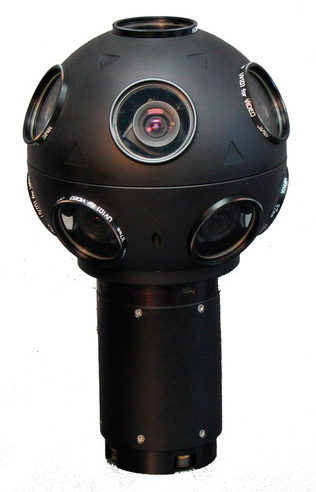 In 2007, Google Maps created a system for documenting every navigable road in the world using nine automated cameras mounted on a vehicle which pauses every 20 meters to capture a panoramic view of that place at street-level. These cameras were devoid of human intervention, creating a documentary blanket over the earth which later became navigable by any user online. In 2008, Jon Rafman began exploring the neutrally captured landscape of Google Street View and collecting screenshots of scenes which interested him, which he posted to the site googlestreetviews.com. Many of these images capture both aware and unsuspecting figures carrying out their daily lives. Facial recognition software is used to remove licence plate numbers and faces from many of the images, but some slip by undetected and a portrait emerges. Rafman saw a resemblance between these candid scenes and street photography, capturing what Henri Cartier-Bresson called 'the decisive moment'. [source]
In 2007, Google Maps created a system for documenting every navigable road in the world using nine automated cameras mounted on a vehicle which pauses every 20 meters to capture a panoramic view of that place at street-level. These cameras were devoid of human intervention, creating a documentary blanket over the earth which later became navigable by any user online. In 2008, Jon Rafman began exploring the neutrally captured landscape of Google Street View and collecting screenshots of scenes which interested him, which he posted to the site googlestreetviews.com. Many of these images capture both aware and unsuspecting figures carrying out their daily lives. Facial recognition software is used to remove licence plate numbers and faces from many of the images, but some slip by undetected and a portrait emerges. Rafman saw a resemblance between these candid scenes and street photography, capturing what Henri Cartier-Bresson called 'the decisive moment'. [source]
For this decisive moment to be captured by Google Street View is one thing, but it is another all together to consider Rafman seeking them out in a methodical survey of the entire digitized globe. What he found was posted to googlestreetviews.com, and it proved to be fruitful. The screenshots Rafman has created have a voyeuristic lens and the ever-present logo of Google, as well as the navigational tools and directional markings present in the virtual system. What emerges is Rafman's street view, his omnificent curatorial eye roving this database landscape, with the framing of the decisive moment under his control. These images capture emotionally charged scenes through an unemotional method, stealing the moment and attributing it to Google, and providing unto the Google user.
Jon Rafman, 58 Lungomare 9 Maggio, Bari, Puglia, Italy , 2009.
In this image captured by Rafman, a woman stands nude at the edge of the sea and stares off into the distance. It is a private moment of reverie, now interlaced with the Google logo. Rafman created a short film entitled 'You, The World and I' in 2010 which creates a narrative around this woman and provides an emotional quest behind the collection of these images.
Jon Rafman |
|
Or this image, which shows an average middle-American man on Main Street wielding an automatic weapon. One must marvel at the odds of this moment and this document. The feeling of voyeurism arises, but is somewhat dampered by the mechanistic method of collection. What becomes clear is that Rafman, not Google, is the voyeur, searching out these scenarios outside of the intended framework in which Google provided them. |
|
This idea features heavily in another work by Rafman called Kool-Aid Man in Second Life. This project, which consists of virtual tours through the MMORPG (Massive Multiplayer Online Role-Playing Game) Second Life by Rafman's avatar, the virtual Kool-Aid pitcher mascot. This virtual world is inhabited by some 500,000 consistent users [source] and has its own currency and economic market. Rafman provides tours to the virtual tourist who wishes to see what goes on within this foreign land. As often is the case with online constituency, it contains the marginalized and the fetishized, expressed anonymously via 3D avatars of the creator's wildest imagination within a dimensional, fictional landscape generated by the users. The availability of these virtual selves to act on fantasies which are distanced from reality–for instance sexual experiences with mythical creatures, beastiality in general, Vorarephilia, flying, etc. Rafman likens this online experience to a return to the womb, a desire to be completely consumed, similar to full immersion in an online life. [source]
| An excerpt from Rafman's tour preview. VIDEO CONTAINS NSFW MATERIAL |
|
| A look at Kool-Aid Man in Second Life by Rafman and artist Lindsay Howard for BOMBlog |
| Nicholas O'Brien and Jon Rafman discuss some of Jon's work in Second Life for Bad at Sports. VIDEO CONTAINS NSFW MATERIAL |
Here again Rafman, through his avatar of Kool-Aid Man, is voyeuristically examining a virtual world, his documentation of that process reframes what he sees within an artistic context via videos, live performances and gallery exhibitions. The other necessary aspect of this online performance is a willing participant with whom Rafman engages while providing the tour. This engagement gives a narrative stability to the experience, where video and still documentation can provide out of context decisive moments which seem to sum up the greater entirety of the experience.
PARKER ITO
Parker Ito is another artist who references his daily existence on the web within his work. His most noted project, The Most Infamous Girl In The History of the Internet, 2010, explores the nature of the stock image that is found on many parked domains. When a URL is purchased but not used, saved to sell or serving as an ad hub, a parked page such as the one seen below exists in the place of genuine content. Many sites use the same framework (seen replicated in the design of parkerito.com), and images. One image happens to be featured on a large number of domains parked by registrar eNom.com, bought from a stock photography agency and continually used as an inoffensive placeholder. Parker became interested in this image and its ubiquitous nature, and commissioned Chinese painting companies to reproduce the .jpg in oil paint. The structure of these Chinese companies is similar to the structure of the companies which buy, park and resell domains; they are not interested in the content or meaning, only the technical service. Any image can be sent to these manufacturers and reproduced in traditional artistic media, to be further bought and sold.
An example of Parked Domain Girl online in her natural habitat A painting of Parked Domain Girl commissioned by Parker Ito in 2010
In the process of sending the same image to a number of art manufacturers, Ito received varying results, winking at the reproducibility of images by the hand of the human artist. The face of the girl, without a name or a context, morphs slightly between paintings, drawing attention to the hand of the "artist" in China, who is also without name or context. In choosing this vaguely familiar image from the internet and elevating it to a status deeming it worthy of reproduction in fine art media, Ito draws attention to both the making and meaning of the art object.
CONCLUSION
 What I see as the thread through these artist's work is their use of or reference to the database nature of our internet existence. Their use of Google image search, Google Street View, internet sites and blogs, and digital effects as sources for their artwork addresses our resources as participants in a digital culture which is very much influenced by our daily use of computers and the internet, which are inherently indexical mechanical interfaces. These artists all, each in their own way, address the nature of art and art making. Is art possible on a blog or within an online virtual world? I believe so, and I also contend that it is an important question to ask in our constantly, instantly changing world. Art exists within and between people, so it must be that where we go, the art will follow. As we venture into the virtual unknown which the future holds, it seems important to note how these things are changing us, and it is the job of artists to explore and experiment within these new boundaries and constraints that the world presents.
What I see as the thread through these artist's work is their use of or reference to the database nature of our internet existence. Their use of Google image search, Google Street View, internet sites and blogs, and digital effects as sources for their artwork addresses our resources as participants in a digital culture which is very much influenced by our daily use of computers and the internet, which are inherently indexical mechanical interfaces. These artists all, each in their own way, address the nature of art and art making. Is art possible on a blog or within an online virtual world? I believe so, and I also contend that it is an important question to ask in our constantly, instantly changing world. Art exists within and between people, so it must be that where we go, the art will follow. As we venture into the virtual unknown which the future holds, it seems important to note how these things are changing us, and it is the job of artists to explore and experiment within these new boundaries and constraints that the world presents.

BIBLIOGRAPHY + NOTES
SCHOLARLY TEXTZ
- Benjamin, Walter. The Work of Art in the Age of Mechanical Reproduction, 1935.
- Bratton, Benjamin H. Mind the Pollocks: (Notes on) Art & Software.
- Chandler and Neumark, ED. At A Distance: Precursors to Art and Activism on the Internet, MIT Press, 2005.
- Fernandez, Maria. "Life-like": Historicizing Process and Responsiveness in Digital Art, in A Companion to Contemporary Art Since 1945, Blackwell Publishing, Malden, MA, 2006.
- Grau, Oliver, ED. MediaArtHistories, MIT Press, 2007.
- Greene, Rachael. Web Work, Artforum Magazine Archive, May, 2000
- Greene, Rachel. Internet Art, Thames & Hudson World of Art, 2004.
- Hansen, Mark B.N. Framing the Digital Image: Embodiment and the Aesthetics of New Media: Introduction, Princeton University, http://a.aaaarg.org/text/1065/introduction-framing-digital-image.
- Hansen, Mark B.N.. Bodies in Code: Interfaces with Digital Media, Routledge, 2006.
- Malloy, Joyce, ED. Women, Art and Technology, MIT Press, Cambridge, 2003.
- Manetas, Miltos, ED. NEEN, Charta Books, 2006.
- Manovich, Lev. The Language of New Media, MIT Press, 2001.
- McHugh, Gene. Post-Internet, http://122909a.com/, 2009-2010.
- McLuhan, Marshall. Understanding Media: The Extensions of Man, 1964.
- Munster, Anna. Materializing New Media: Embodiment in Information Aesthetics, Dartmouth College Press, 2006.
- Parreno, Phillippe. Interview with Rafael Rosendaal, First Person Magazine, Issue 002, Fall 2008, pp. 52-56.
- Paul, Christine, ED. New Media in the White Cube and Beyond: Curatorial Models for Digital Art, University of California Press, 2008.
- Vesna, Victoria, ED. Database Aesthetics: Art in the Age of Information Overflow, University of Minnesota Press, 2007.
- Wilson, Stephen, ED. Information Arts: Intersections of Art, Science and Technology, MIT Press, Cambridge, 1995.
General Internet Art Online Resourcez
- Rhizome.org is an invaluable resource and community which is part of the New Museum in New York.
- Gene McHugh was the recipient of a Creative Capital | Andy Warhol Foundation Arts Writers grant and kept the inspiring blog of his writing called Post Internet.
- Nicholas O'Brien writes about and makes internet art. See also: Notes on a New Nature.
- Tom Moody writes about and makes internet art.
- Curt Cloninger writes about and makes internet art.
- ArtFagCity sometimes writes about internet things.
- The Pulse makes fun of internet art nerds.
Artists I Didn't Get To Yet That You Could Check Out Via These Links
Brad Troemel
-The Jogging
-Performanceart
-ASSEMBELY
-An Immaterial Survey of Our PeersComputers Club
-Krist Wood
-Petra Cortright
-René Abythe
-Rafael Rosendaal
-Duncan Malashock
-Travess Smalley
-Robert Lorayn
-Alexandria McCrosky
-Daniel L. Williams
-Francoise Gamma
-Nicholas Sassoon
-Sara Ludy
-Laura BrothersJon Michael Boling
-gooooooooooooooooooooooooooooooooooooooooooooooooooooogle.comJon Rafman
-Brand New Paint Job
Ryder Ripps
-dump.fm
-Internet ArchaeologyJstChillin
(by Parker Ito and Caitlin Denny)
-Avatar 4d ExhibitionSurf Clubs
-Nasty Nets
-Loskadka
Tabor Robak
Brenna Murphy
Constant Dullaart
